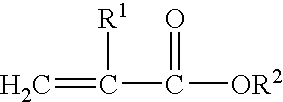Block copolymer hot-melt processable adhesives, methods of their preparation, and articles therefrom
a technology of processable adhesives and block copolymer, which is applied in the direction of heat-activated film/foil adhesives, film/foil adhesives, transportation and packaging, etc., can solve the problems of e-beam not always desired, reduced processing efficiency, and damage to some backings
- Summary
- Abstract
- Description
- Claims
- Application Information
AI Technical Summary
Benefits of technology
Problems solved by technology
Method used
Image
Examples
examples
[0119]
Abbreviation of CompoundsAbbreviationFull NameDPE1,1-diphenylethylene, commerciallyavailable from Aldrich Chemical,Milwaukee, WI, and vacuum distilledfrom sec-butyl lithium and diluted bytoluene to a concentration of about 0.3moles / literEAethyl acrylateEGDMAethyleneglycol dimethacrylate,commercially available from AldrichChemical, Milwaukee, WIFORAL 105a rosin ester, commercially availablefrom Hercules, Inc., Wilmington, DEunder the trade designation FORAL105iOAisooctyl acrylateLiCl99.99% pure, commercially availablefrom Aldrich Chemical, Milwaukee,WI, and dried under vacuum at 130° C.MMAmethyl methacrylate, commerciallyavailable from Aldrich Chemical,Milwaukee, WI, purified by refluxingover calcium hydride, vacuumdistilling, and storing under a nitrogenatmosphere at −20° C.nBAn-butyl acrylate, commerciallyavailable from Aldrich Chemical,Milwaukee, WIPApropyl acrylatePEPolyethylenePETpolyethylene terephthalatePLASTHALLan aliphatic plasticizer, commerciallyDIODDavailable from C...
example 1
Synthesis of MMA-iOA-MMA Copolymers
Step I: Preparation of MMA-tBA-MMA Copolymers
[0134]The same general procedure was used to generate a series of MMA-tBA-MMA block copolymers. The reagents used to prepare the each specific copolymer are listed in Table 1.
[0135]To a glass flask that was flame-dried and purged with nitrogen was added a desired amount of LiCl. THF and DPE were added to the flask using rubber septa and stainless steel capillaries (THF) or syringes (DPE). A 3-fold molar excess of DPE and a 5-fold molar excess of LiCl (based on the amount of sec-butyl lithium initiator, infra) was used.
[0136]An initiator solution of sec-butyl lithium in cyclohexane having a molarity of 0.25 moles / liter (the initiator solution was further diluted from a commercially available from Aldrich Chemical, Milwaukee, Wis. having a molarity of 1.3 moles / liter) was added dropwise to the reaction flask until a red color persisted (the color of the organic anion, indicating that any remaining moisture...
PUM
| Property | Measurement | Unit |
|---|---|---|
| Current | aaaaa | aaaaa |
| Digital information | aaaaa | aaaaa |
| Glass transition temperature | aaaaa | aaaaa |
Abstract
Description
Claims
Application Information
 Login to View More
Login to View More - R&D
- Intellectual Property
- Life Sciences
- Materials
- Tech Scout
- Unparalleled Data Quality
- Higher Quality Content
- 60% Fewer Hallucinations
Browse by: Latest US Patents, China's latest patents, Technical Efficacy Thesaurus, Application Domain, Technology Topic, Popular Technical Reports.
© 2025 PatSnap. All rights reserved.Legal|Privacy policy|Modern Slavery Act Transparency Statement|Sitemap|About US| Contact US: help@patsnap.com



